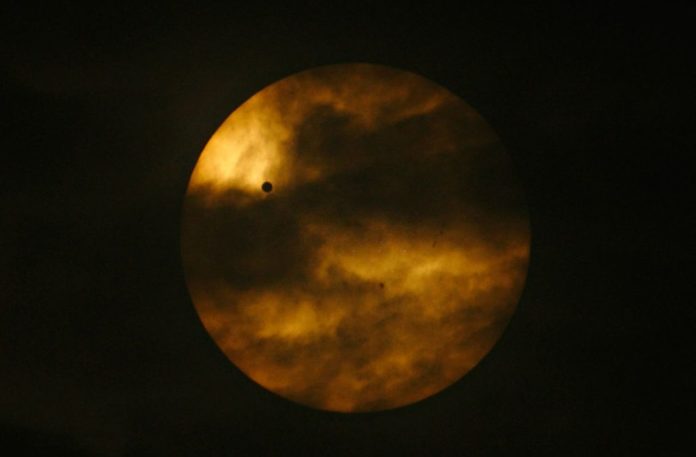It’s difficult to picture a more hostile place than our nearest planetary neighbor. Venus is a burned and suffocating wasteland where life as we know it could not live, with an atmosphere heavy with carbon dioxide and a surface hot enough to melt lead.
The planet’s clouds are similarly hostile, blanketing it with sulfuric acid droplets corrosive enough to burn a hole through human skin.
Nonetheless, a recent study backs up the long-held belief that if life exists, it may build a home in Venus’ clouds. The researchers from MIT, Cardiff University, and Cambridge University discovered a chemical pathway through which life may neutralize Venus’ acidic atmosphere, forming a self-sustaining, habitable pocket in the clouds.
Scientists have long identified perplexing anomalies in Venus’ atmosphere – chemical traces that are difficult to explain, such as low oxygen concentrations and nonspherical particles in contrast to sulfuric acid’s round droplets. The existence of ammonia, a gas that was initially found in the 1970s and that, by all accounts, should not be created by any chemical process known on Venus, is perhaps the most perplexing.
In their latest paper, the researchers used a computer simulation to show that if ammonia is present, it will trigger a chain of chemical reactions that will neutralize surrounding sulfuric acid droplets, explaining the majority of the anomalies seen in Venus’ clouds. In terms of the origin of ammonia, scientists believe that biological sources are more likely than nonbiological sources such as lightning or volcanic eruptions.
The chemistry shows that “life could be making its own environment on Venus,” as scientists write in their study.
This fascinating new concept is testable, and the researchers present a list of chemical signatures for future missions to detect in Venus’ clouds to confirm or refute their notion.
“No life that we know of could survive in the Venus droplets,” said study co-author Sara Seager.
“But the point is, maybe some life is there, and is modifying its environment so that it is livable.”
The study’s co-authors include Janusz Petkowski, William Bains, and Paul Rimmer, who are affiliated with MIT, Cardiff University, and Cambridge University.
Life suspect
Last year, when scientists including Seager and her co-authors reported the discovery of phosphine in the planet’s clouds, the phrase “life on Venus” became popular. On Earth, phosphine is a gas that is mostly created through biological interactions. The finding of phosphine on Venus raises the prospect of life. However, the discovery has been widely challenged since then.
“The phosphine detection ended up becoming incredibly controversial,” Seager said. “But phosphine was like a gateway, and there’s been this resurgence in people studying Venus.”
Paul Rimmer, study’s another co-author, became intrigued and began going through data from previous flights to Venus. He discovered anomalies, or chemical signatures, in the clouds that had gone unnoticed for decades in these data. Aside from the existence of oxygen and nonspherical particles, there were also surprising levels of water vapor and sulfur dioxide.
Dust, according to Rimmer, could explain the abnormalities. He contended that minerals swept up from Venus’s surface and into the clouds could combine with sulfuric acid to cause some, but not all, of the observed anomalies. He demonstrated that the chemistry was correct, but the physical conditions were impractical: a tremendous volume of dust would have to rise into the clouds to create the observed anomalies.
Seager and her colleagues questioned if ammonia may explain the anomalies. The Venera 8 and Pioneer Venus missions found the gas in the planet’s clouds in the 1970s. The presence of ammonia, or NH3, remained a mystery.
“Ammonia shouldn’t be on Venus,” Seager added. “It has hydrogen attached to it, and there’s very little hydrogen around. Any gas that doesn’t belong in the context of its environment is automatically suspicious for being made by life.”
Livable clouds
Could the team’s assumption that life was the source of ammonia explain the other anomalies in Venus’ clouds? In order to find an explanation, the researchers modeled a series of chemical reactions.
They discovered that if life produced ammonia as efficiently as possible, the underlying chemical reactions would naturally produce oxygen. Ammonia, once present in the clouds, would dissolve in droplets of sulfuric acid, essentially neutralizing the acid and making the droplets livable. The addition of ammonia to the droplets changes their formerly round, liquid structure into a nonspherical, salt-like slurry. When ammonia dissolves in sulfuric acid, the reaction causes any nearby sulfur dioxide to dissolve as well.
The presence of ammonia might possibly explain the majority of the significant anomalies observed in Venus’ clouds. The researchers also show that causes such as lightning, volcanic eruptions, and even a meteorite strike cannot produce the amount of ammonia needed to explain the anomalies chemically. However, life may.
Indeed, the research observes that there are life-forms on Earth, specifically in human stomachs, that produce ammonia to neutralize and make livable an otherwise highly acidic environment.
“There are very acidic environments on Earth where life does live, but it’s nothing like the environment on Venus — unless life is neutralizing some of those droplets,” Seager said.
Scientists may be able to check for the existence of ammonia and other indicators of life in the coming years thanks to the Venus Life Finder Missions, a collection of proposed privately sponsored missions led by Seager that seek to send spacecraft to Venus to measure its clouds for ammonia and other signs of life.
“Venus has lingering, unexplained atmospheric anomalies that are incredible,” Seager added. “It leaves room for the possibility of life.”
Image Credit: Getty
You were reading: Study reveals a very acidic theory that neutralizes Venus’ toxic environment
